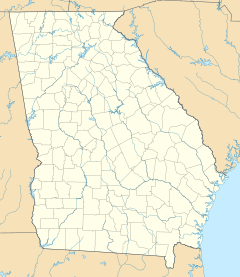Oketeyeconne, Georgia facts for kids
Quick facts for kids
Oketeyeconne, Georgia
Oketeyeconne Community
|
|
|---|---|
| Country | United States |
| State | Georgia |
| County | Clay |
| Elevation | 200 ft (60 m) |
| Time zone | UTC-5 (Eastern (EST)) |
| • Summer (DST) | UTC-4 (EDT) |
Oketeyeconne was a small community in Clay County, Georgia, USA. It was located right by the Chattahoochee River. In the 1940s, the United States Army Corps of Engineers built a big dam and lake on the river. This new lake, called Walter F. George Lake, covered 46,000 acres.
Building the lake meant that Oketeyeconne and its residents had to move. The town was flooded and became a ghost town. The lake officially opened in 1963.
Contents
Where Was Oketeyeconne?
Oketeyeconne's exact location was at 31.6432225 latitude and -85.0804849 longitude. The town is now completely underwater, buried under more than 90 feet of water in Walter F. George Lake. If you have a special depth finder on a boat, you might be able to find its old location!
A Look at Oketeyeconne's Past
Early Life by the River
Archeologists have found signs that people lived along the Chattahoochee River thousands of years ago. These were indigenous peoples, meaning they were the first people to live in that area. They have been there since at least 1000 BC.
In the late 1700s, Oketeyeconne was known as a town of the Lower Creek tribe. The people there spoke the Hitchiti language. Oketeyeconne was the southernmost major town connected to the Lower Creek. Other Native American groups like the Sawokli, Tamathli, Apalachicola, Yamasee, Mikasuki, and Seminole lived further south.
Life in the Late 1700s
In 1799, a man named Benjamin Hawkins visited Oketeyeconne. He was a US official who worked with Native American tribes. He described Oketeyeconne as a "nice town" with good land for farming and raising animals. Hawkins wanted Native Americans to learn European-American farming methods. He even lived among the Creek people to help them.
Challenges in the 1800s
In the early 1800s, more and more white settlers moved into the area. This caused problems for the Native Americans in Oketeyeconne. They faced food shortages and lost their land. After the Creek Wars, many Native American refugees came to the area. They had been defeated in a battle by Andrew Jackson and the US Army.
In 1813, some people from Oketeyeconne asked the British for help. They had traded with the British for a long time, even before the American Revolutionary War. During the War of 1812, the British wanted Native Americans to be their allies against the United States. Some people thought the Native Americans in the area were helping the British.
During the Civil War
During the American Civil War, the people of Oketeyeconne had different ideas about who to support. Some sided with the Confederacy, and others with the Union. Most of the town's residents were Native Americans. These were descendants of people who had managed to stay in their homes after the Indian Removal in the 1830s. Some had even agreed to become citizens of the state.
The Muskogee-speaking Creek people often supported the Union during the war. However, descendants of Seminole and other tribes who had been affected by earlier conflicts sometimes sided with the Confederacy.
The Town Disappears
Oketeyeconne was never officially made a city or town. In the mid-1900s, the US government decided to build dams and control the river's water. This meant the town had to be moved. The United States Army Corps of Engineers built the large dam and the 46,000-acre Walter F. George Lake. The construction of the lake caused Oketeyeconne to be flooded. The lake opened for use in 1963, and Oketeyeconne disappeared under its waters.
Remembering Oketeyeconne
In 1989, a special historical marker was placed on a nearby highway. This marker tells the story of Oketeyeconne's Native American past and its role in the War of 1812. It helps people remember the community that once existed there.



